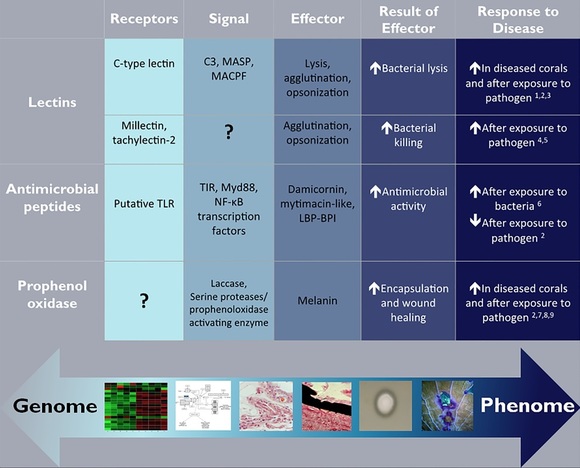The Mydlarz lab perspective on Cnidarian and coral immunity
|
Cnidarian and coral immunity is comprised of four categories of processes that enable the organism to recognize that it is under attack, kill the foreign perpetrator, and repair the wound. There are four major functions of the cnidarian immune system: (1) immune recognition, (2) intracellular signaling, (3) effector response and (4) tissue repair. The first step, recognition of a pathogen, leads to the activation of the immune system. This is accomplished by membrane bound receptors that bind directly to molecular patterns in pathogens. For example, pattern recognition receptors, or PRRs, recognize pathogen/microbe-associated molecular patterns (PAMPs), such as lipopolysaccharides (LPS) from bacteria or β-glucans from fungi, and transmit the signal internally. The signal transduction mediators, signaling molecules and transcription factors that communicate the signal within the cell, comprise the intracellular signaling component of immunity . The end-points of the signaling cascades are the proteins and molecules that kill the pathogen. These can comprise antibacterial proteins and small molecules, reactive oxygen and nitrogen molecules, and cellular activity and barriers. These effectors can be variable and novel among different Cnidarian taxa. Finally, the organism must seal off the infection and detoxify the tissue in order to heal the wound.
|

One of goals of the Mydlarz lab is to connect what is known about the presence of immune genes to phenotypes of either immunity itself or disease resistance. It is clear that for many of the known immune pathways, information providing a direct connection between genome and phenotype either exists in fragmented form or does not exist at all. There is also a disparity in the type of information available on each of the four stages of immunity. For example, receptor identity and signaling cascades are heavily reflected in genomic data, with the presence of gene homologs in genomes and transcriptomes, while information on effector responses and, to some extent wound repair, rely predominantly on observations of cellular, biochemical and antimicrobial activity.
Work in the Mydlarz lab wants to pair gene expression data to phenotype links to understand the initaion and execution of a specifc arm of immunity. For example, in other invertebrate systems, activation of Toll-like Receptors (TLR) and subsequent signaling pathways lead to up-regulation of Antimicrobial Peptides (AMPs) or bactericidal. While these elements have been identified in the Cnidaria, the connections between the entire cascade are not fully understood. See neighboring figure.
Another main goal of understanding cnidarian immunity is elucidating which elements lead to organismal disease resistance. Diseases affecting scleractinian corals, one of the cnidarian groups hardest hit by disease, are caused by a diversity of etiological agents (e.g., bacteria, fungi, viruses, etc.), increasing the challenge of this endeavor. It is unlikely that one cascade or PRR is responsible for resistance against all types of pathogens, but identifying the genetic basis of variation in susceptibility to a particular disease will help aid in predicting population-wide consequences of a disease outbreak. To date, several phenotypes have been linked to species-specific disease resistance, including PO/PPO and antimicrobial activity, but the basis for this variation is not well understood.
Work in the Mydlarz lab wants to pair gene expression data to phenotype links to understand the initaion and execution of a specifc arm of immunity. For example, in other invertebrate systems, activation of Toll-like Receptors (TLR) and subsequent signaling pathways lead to up-regulation of Antimicrobial Peptides (AMPs) or bactericidal. While these elements have been identified in the Cnidaria, the connections between the entire cascade are not fully understood. See neighboring figure.
Another main goal of understanding cnidarian immunity is elucidating which elements lead to organismal disease resistance. Diseases affecting scleractinian corals, one of the cnidarian groups hardest hit by disease, are caused by a diversity of etiological agents (e.g., bacteria, fungi, viruses, etc.), increasing the challenge of this endeavor. It is unlikely that one cascade or PRR is responsible for resistance against all types of pathogens, but identifying the genetic basis of variation in susceptibility to a particular disease will help aid in predicting population-wide consequences of a disease outbreak. To date, several phenotypes have been linked to species-specific disease resistance, including PO/PPO and antimicrobial activity, but the basis for this variation is not well understood.
